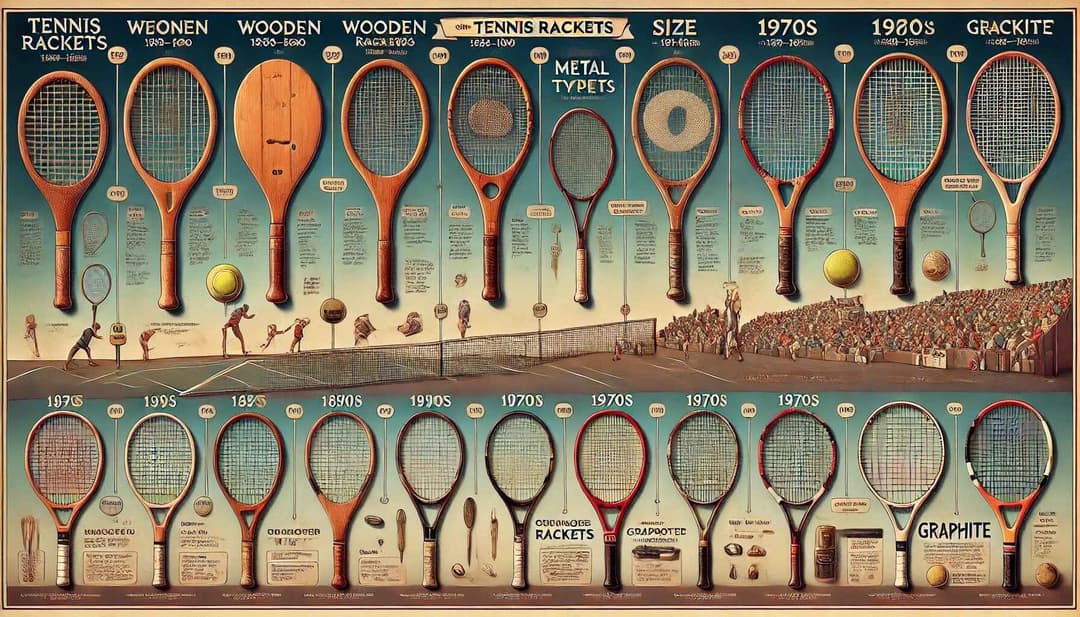As we gear up for another exciting US Open, it's fascinating to consider how much the game has changed over the years. One of the most significant evolutions in tennis has been the development of the racket. From the wooden frames of yesteryear to today's high-tech graphite marvels, let's take a journey through the history of tennis rackets and see how they've transformed the sport.
The Wooden Era: 1870s-1960s
Tennis, as we know it, began in the 1870s, and for nearly a century, wood was the material of choice for rackets.
- Characteristics: Heavy (12-14 oz), small heads (65 sq. inches), flexible
- Notable players: Bill Tilden, Don Budge, Rod Laver
- Pros: Durability, feel
- Cons: Weight, small sweet spot
Wooden rackets required great skill to wield effectively. Players needed to hit the ball precisely in the center of the strings to achieve power and accuracy. This era favored players with excellent timing and touch.
The Metal Revolution: 1960s-1970s
In 1967, Wilson Sporting Goods introduced the T2000 steel racket, famously used by Jimmy Connors.
- Characteristics: Lighter than wood, larger heads (75-80 sq. inches), stiffer
- Notable players: Jimmy Connors, Billie Jean King
- Pros: More power, larger sweet spot
- Cons: Vibration, less feel
Metal rackets allowed for more power and a larger sweet spot, making the game more accessible to recreational players. However, they also transmitted more vibration to the arm, potentially leading to injuries.
The Oversized Revolution: 1970s
In 1976, Howard Head patented the oversized racket head, which Prince brought to market with their Prince Classic.
- Characteristics: Even larger heads (110 sq. inches), more power
- Notable players: Pam Shriver
- Pros: Much larger sweet spot, more power
- Cons: Less control for advanced players
This innovation dramatically changed the game, making it easier for beginners to hit the ball effectively and increasing power for all players.
The Graphite Age: 1980s-Present
In the 1980s, manufacturers began using graphite and other composite materials, leading to the modern racket.
- Characteristics: Light (9-11 oz), large heads (95-110 sq. inches), stiff but with controlled flexibility
- Notable players: Roger Federer, Serena Williams, Rafael Nadal
- Pros: Excellent combination of power and control, customizable
- Cons: Can be expensive, may enable "too much" power for some traditionalists
Graphite rackets offer an unparalleled combination of power, control, and feel. They can be fine-tuned for weight, balance, and stiffness, allowing players to customize their equipment to their playing style.
The Impact on the Game
The evolution of rackets has had a profound impact on tennis:
Serving: Serves have become much faster. In 1997, Mark Philippoussis set a record with a 142.3 mph serve. Today, John Isner holds the record at 157.2 mph.
Rally length: Points tend to last longer as players can generate pace from defensive positions.
Playing styles: The variety of playing styles has increased. While serve-and-volley play has decreased, baseline power games and all-court play have thrived.
Spin: Modern rackets allow players to generate unprecedented amounts of spin, leading to shots like Rafael Nadal's topspin-heavy forehand.
The Future of Racket Technology
As materials science and engineering continue to advance, we can expect further innovations in racket technology. Some areas of potential development include:
- Smart rackets with embedded sensors for data analysis
- More environmentally friendly materials
- Further customization options
However, the International Tennis Federation (ITF) closely regulates racket specifications to maintain the integrity of the game, so any future changes are likely to be incremental rather than revolutionary.
Conclusion
From the wooden rackets of the 19th century to today's high-tech graphite models, the evolution of tennis rackets mirrors the sport's journey into the modern era. As we watch the powerful serves and grueling rallies at this year's US Open, we can appreciate how far the equipment has come – and wonder what innovations the future might hold for this beloved sport.

